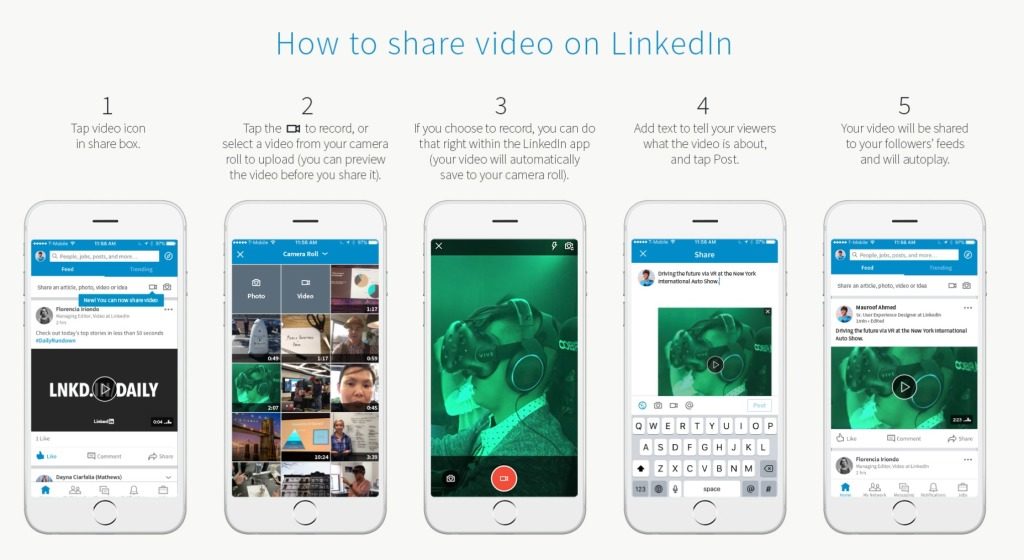Long after all the other social media giants have adopted video sharing features, LinkedIn has finally jumped on the bandwagon. The business-centric social media network will now let users take and upload videos with the updated in-app camera or upload clips from their phone’s camera roll. Currently, LinkedIn says the native video feature is currently being tested with a batch of users and publishers, and they plan to bring the long overdue feature to all users in the coming months. For the time being, native videos cannot be published through desktop computers, only mobile devices. For those who prefer high-quality productions, these videos can be created on your desktop, transferred to, and then uploaded through the LinkedIn app on a mobile device.
For those of you who might already have it, here’s a guide from LinkedIn on how to access the feature.
What does this mean for B2B marketers?
In a previous post, we talked about how video will dominate the marketing landscape in 2017, and it seems to be holding true. Besides contributing to higher retention rates, higher engagement, better SEO, and increased conversions, video content currently makes up about 74% of all internet traffic and Cisco, the worldwide leader in IT and Networking, projects that video will make up about 80% of internet traffic by 2019. As we know, LinkedIn is the largest network of professionals in a single location. This makes it easy to connect with others and build relationships in order to provide valuable information and support.
The introduction of video will help make this a much easier and entertaining experience. Users will be able to snap video on their phone while on the go, at trade shows, in meetings, etc. and post in an instant.
These videos can last up to 10 minutes, though LinkedIn recommends a shorter length ranging between 30 seconds and five minutes. As with LinkedIn’s pre-existing in-feed videos, user-uploaded clips will play automatically with sound off. Like Facebook and Twitter, LinkedIn counts a video view after three seconds of play time. This will help to weed out those who aren’t as interested and give you a better idea of your demographic and whether you’re reaching the audience you are targeting. This will also help to understand if your videos are resonating with those who are watching. If the majority of your viewers stop watching within the first 3 seconds, you may have to reevaluate your strategy, whether it be the quality of your video or content, or if you are targeting the wrong audience.
Users will have access to the typical analytic information provided by social platforms plus the addition of some extra perks that B2B marketers could have only dreamed of before. For a selection of top viewers, you will be provided with where they work, their job title and the top markets where the video was viewed. Not bad, eh? No other social media platform currently provides this degree of information. This makes it easier to align your goals and gather information.
Having these unique analytics available will be a huge benefit to networking opportunities and generating sales leads. You could post a video highlighting a new product or a demo video and information will be collected without much effort on the viewers part. No popups, landing pages, or gated content interrupting them to fill out information. This data can then be used to build up a list of prospects.
When paired with video, LinkedIn will be a B2B marketers delight.
To see how you can prepare and get the most out of this great new feature by LinkedIn, check out:
Why you should invest in video and 5 tips on producing quality videos
6 steps to creating contagious content.
Conclusion
With video on the rise, LinkedIn’s better-late-than-never strategy is poised to be a hit within the B2B community. This new feature will provide businesses with the opportunity to take advantage of the rising demand for video content, on the ideal platform for B2B companies, to assist in telling their story and building credibility among followers.


